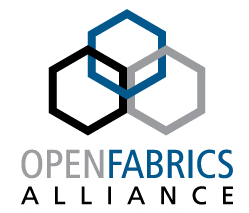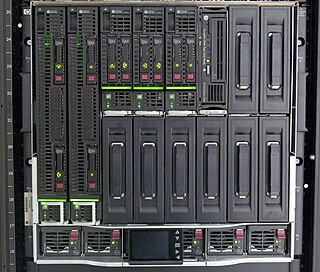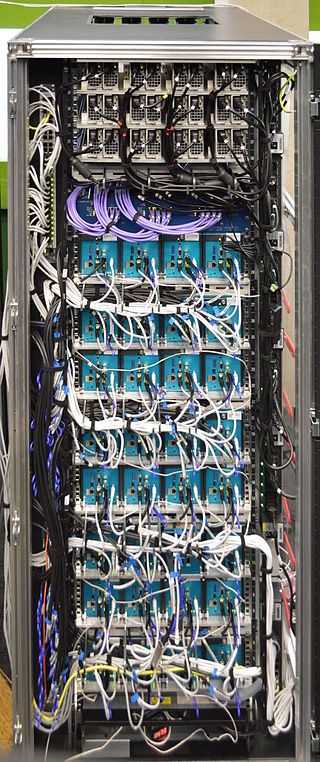Myrinet, ANSI/VITA 26-1998, is a high-speed local area networking system designed by the company Myricom to be used as an interconnect between multiple machines to form computer clusters.

PCI Express, officially abbreviated as PCIe or PCI-e, is a high-speed serial computer expansion bus standard, designed to replace the older PCI, PCI-X and AGP bus standards. It is the common motherboard interface for personal computers' graphics cards, sound cards, hard disk drive host adapters, SSDs, Wi-Fi and Ethernet hardware connections. PCIe has numerous improvements over the older standards, including higher maximum system bus throughput, lower I/O pin count and smaller physical footprint, better performance scaling for bus devices, a more detailed error detection and reporting mechanism, and native hot-swap functionality. More recent revisions of the PCIe standard provide hardware support for I/O virtualization.

HIPPI, short for High Performance Parallel Interface, is a computer bus for the attachment of high speed storage devices to supercomputers, in a point-to-point link. It was popular in the late 1980s and into the mid-to-late 1990s, but has since been replaced by ever-faster standard interfaces like Fibre Channel and 10 Gigabit Ethernet.

Quadrics was a supercomputer company formed in 1996 as a joint venture between Alenia Spazio and the technical team from Meiko Scientific. They produced hardware and software for clustering commodity computer systems into massively parallel systems. Their highpoint was in June 2003 when six out of the ten fastest supercomputers in the world were based on Quadrics' interconnect. They officially closed on June 29, 2009.

Small Form-factor Pluggable (SFP) is a compact, hot-pluggable network interface module format used for both telecommunication and data communications applications. An SFP interface on networking hardware is a modular slot for a media-specific transceiver, such as for a fiber-optic cable or a copper cable. The advantage of using SFPs compared to fixed interfaces is that individual ports can be equipped with different types of transceivers as required, with the majority including optical line terminals, network cards, switches and routers.
TCP offload engine (TOE) is a technology used in some network interface cards (NIC) to offload processing of the entire TCP/IP stack to the network controller. It is primarily used with high-speed network interfaces, such as gigabit Ethernet and 10 Gigabit Ethernet, where processing overhead of the network stack becomes significant. TOEs are often used as a way to reduce the overhead associated with Internet Protocol (IP) storage protocols such as iSCSI and Network File System (NFS).
In computing, remote direct memory access (RDMA) is a direct memory access from the memory of one computer into that of another without involving either one's operating system. This permits high-throughput, low-latency networking, which is especially useful in massively parallel computer clusters.

The IBM BladeCenter was IBM's blade server architecture, until it was replaced by Flex System in 2012. The x86 division was later sold to Lenovo in 2014.
40 Gigabit Ethernet (40GbE) and 100 Gigabit Ethernet (100GbE) are groups of computer networking technologies for transmitting Ethernet frames at rates of 40 and 100 gigabits per second (Gbit/s), respectively. These technologies offer significantly higher speeds than 10 Gigabit Ethernet. The technology was first defined by the IEEE 802.3ba-2010 standard and later by the 802.3bg-2011, 802.3bj-2014, 802.3bm-2015, and 802.3cd-2018 standards. The first succeeding Terabit Ethernet specifications were approved in 2017.

The OpenFabrics Alliance is a non-profit organization that promotes remote direct memory access (RDMA) switched fabric technologies for server and storage connectivity. These high-speed data-transport technologies are used in high-performance computing facilities, in research and various industries.
The Cray CX1 is a deskside workstation designed by Cray Inc., based on the x86-64 processor architecture. It was launched on September 16, 2008, and was discontinued in early 2012. It comprises a single chassis blade server design that supports a maximum of eight modular single-width blades, giving up to 96 processor cores. Computational load can be run independently on each blade and/or combined using clustering techniques.

BladeSystem is a line of blade server machines from Hewlett Packard Enterprise that was introduced in June 2006.

IPtronics was a fabless semiconductor company headquartered in Copenhagen, Denmark. Its products include integrated circuits for parallel optical interconnect applications intended for the computer, storage and communication industries. IPtronics' design center is certified by STMicroelectronics, which is also their semiconductor foundry partner. In June 2013, IPtronics was acquired by Mellanox Technologies.
NVM Express (NVMe) or Non-Volatile Memory Host Controller Interface Specification (NVMHCIS) is an open, logical-device interface specification for accessing a computer's non-volatile storage media usually attached via the PCI Express bus. The initial NVM stands for non-volatile memory, which is often NAND flash memory that comes in several physical form factors, including solid-state drives (SSDs), PCIe add-in cards, and M.2 cards, the successor to mSATA cards. NVM Express, as a logical-device interface, has been designed to capitalize on the low latency and internal parallelism of solid-state storage devices.

In computing, Linux-IO (LIO) Target is an open-source implementation of the SCSI target that has become the standard one included in the Linux kernel. Internally, LIO does not initiate sessions, but instead provides one or more Logical Unit Numbers (LUNs), waits for SCSI commands from a SCSI initiator, and performs required input/output data transfers. LIO supports common storage fabrics, including FCoE, Fibre Channel, IEEE 1394, iSCSI, iSCSI Extensions for RDMA (iSER), SCSI RDMA Protocol (SRP) and USB. It is included in most Linux distributions; native support for LIO in QEMU/KVM, libvirt, and OpenStack makes LIO also a storage option for cloud deployments.

The Dell blade server products are built around their M1000e enclosure that can hold their server blades, an embedded EqualLogic iSCSI storage area network and I/O modules including Ethernet, Fibre Channel and InfiniBand switches.
RDMA over Converged Ethernet (RoCE) or InfiniBand over Ethernet (IBoE) is a network protocol which allows remote direct memory access (RDMA) over an Ethernet network. It does this by encapsulating an InfiniBand (IB) transport packet over Ethernet. There are multiple RoCE versions. RoCE v1 is an Ethernet link layer protocol and hence allows communication between any two hosts in the same Ethernet broadcast domain. RoCE v2 is an internet layer protocol which means that RoCE v2 packets can be routed. Although the RoCE protocol benefits from the characteristics of a converged Ethernet network, the protocol can also be used on a traditional or non-converged Ethernet network.

Mellanox Technologies Ltd. was an Israeli-American multinational supplier of computer networking products based on InfiniBand and Ethernet technology. Mellanox offered adapters, switches, software, cables and silicon for markets including high-performance computing, data centers, cloud computing, computer data storage and financial services.

QPACE 2 is a massively parallel and scalable supercomputer. It was designed for applications in lattice quantum chromodynamics but is also suitable for a wider range of applications..

Summit or OLCF-4 is a supercomputer developed by IBM for use at Oak Ridge Leadership Computing Facility (OLCF), a facility at the Oak Ridge National Laboratory, capable of 200 petaFLOPS thus making it the 5th fastest supercomputer in the world after Frontier (OLCF-5), Fugaku, LUMI, and Leonardo, with Frontier being the fastest. It held the number 1 position from November 2018 to June 2020. Its current LINPACK benchmark is clocked at 148.6 petaFLOPS.














